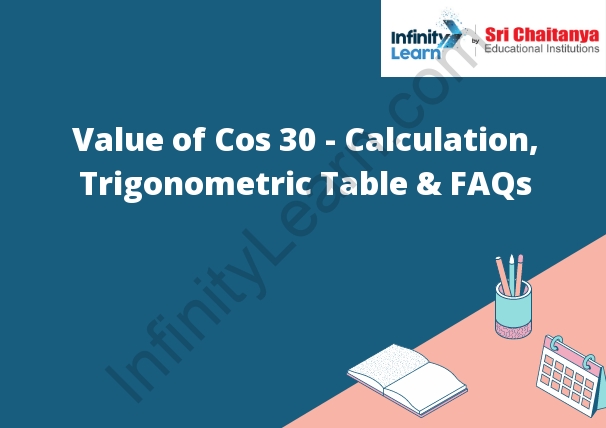Table of Contents
Value of Cos 30 – Calculation, Trigonometric Table & FAQs
The value of cos 30 can be calculated using the trigonometric table, which is a table of values that shows the relationship between the angles of a triangle and the sides of the triangle. The trigonometric table can be found in most math textbooks. To calculate the value, we first have to find the value of sin 30 in the trigonometric table. Then, divide the value of sin 30 by the value of cos 30. The value of cos 30 is 0.5.

Value of Cos 30 Trigonometric Table
The value of cos 30° lies between 1 and 0. Cos 30° = 0.86603. Cos 30° can be calculated without the use of a calculator by using the trigonometric table or by using the formula: cos 30° = cos(45° – 15°). Therefore Cos 30° can also calculated by using the identity: cos 30° = sqrt(3)/2.
Cos 30° can calculated without the use of a calculator by using the trigonometric table or by using the formula: cos 30° = cos(45° – 15°). However Cos 30° can also calculated by using the identity: cos 30° = sqrt(3)/2.
Cos 30° = 0.86603.
Related Links
| Cos 30 Degree | Value of Sin 180 |
| Sin 60 Degree | Sin 120 |
| Sin Cos Tan Values | Cos 90 Value |
FAQs on Value of Cos 30
Cos 30 is the cosine of 30 degrees. It is a trigonometric function that often used in mathematical and scientific calculations.
There are many benefits of using cos 30. Cos 30 can used to calculate angles, distances, and other values in mathematical and scientific calculations.
Cos 30 often used in mathematical and scientific calculations to calculate angles, distances, and other values.
Cos 30 has many applications. Some of the applications of cos 30 include calculating angles, distances, and other values in mathematical and scientific calculations.
There are some drawbacks of using cos 30. One of the drawbacks of using cos 30 is that it can sometimes give inaccurate results. What is cos 30?
What are the benefits of using cos 30?
How cos 30 used in mathematical and scientific calculations?
What are some of the applications of cos 30?
What are some of the drawbacks of using cos 30?







